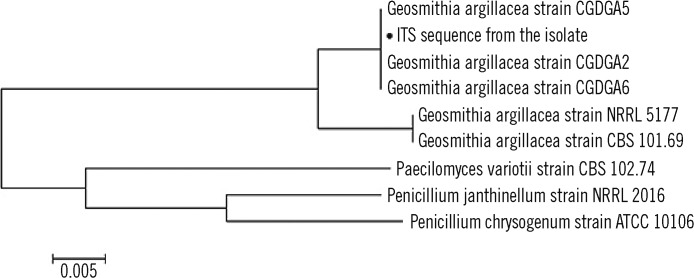Ann Lab Med.
2013 Mar;33(2):136-140. 10.3343/alm.2013.33.2.136.
Isolation and Identification of Geosmithia argillacea from a Fungal Ball in the Lung of a Tuberculosis Patient
- Affiliations
-
- 1Department of Laboratory Medicine and Genetics, Samsung Medical Center, Sungkyunkwan University School of Medicine, Seoul, Korea. mrmicro@skku.edu, changski@skku.edu
- KMID: 1781314
- DOI: http://doi.org/10.3343/alm.2013.33.2.136
Abstract
- Geosmithia argillacea, an anamorph of Talaromyces eburneus, is a thermophilic filamentous fungus that has a phenotype similar to that of the Penicillium species, except for the creamy-white colonies and cylindrical conidia. Recently, a new genus called Rasamsonia has been proposed, which is to accommodate the Talaromyces and Geosmithia species. Here, we report the first Korean case of G. argillacea isolated from a patient with a fungal ball. The patient was a 44-yr-old Korean man with a history of pulmonary tuberculosis and aspergilloma. The newly developed fungal ball in his lung was removed and cultured to identify the fungus. The fungal colonies were white and slow-growing, and the filaments resembled those of Penicillium. Molecular identification was carried out by sequencing the internal transcribed spacer (ITS) region of the 28S rDNA and the beta-tubulin genes. A comparative sequence analysis using the GenBank (http://blast.ncbi.nlm.nih.gov/) database was performed with the basic local alignment search tool (BLAST) algorithm. The results revealed a 97-100% similarity with the G. argillacea ITS sequence. This case should increase awareness among physicians about the pathogenic potential of G. argillacea in humans and help them accurately identify this fungus, because it can be easily confused with Penicillium and Paecilomyces species owing to their similar phenotypic and microscopic characteristics. A molecular approach should be employed to enable accurate identification of G. argillacea.
Keyword
MeSH Terms
-
Adult
Databases, Genetic
Eurotiales/classification/*isolation & purification
Humans
Lung/microbiology/radiography
Male
Phylogeny
RNA, Ribosomal, 28S/chemistry/genetics
Sequence Analysis, DNA
Tomography, X-Ray Computed
Tuberculosis/*diagnosis/microbiology/radiography
Tubulin/chemistry/genetics
RNA, Ribosomal, 28S
Tubulin
Figure
Reference
-
1. Stolk AC, Evans HC, Nilsson T. Penicillium argillaceum sp.nov., a thermotolerant Penicillium. Trans Br Mycol Soc. 1969; 53:307–311.2. Pitt JI. Geosmithia gen. nov. for Penicillium lavendulum and related species. Can J Bot. 1979; 57:2021–2030.3. Yaguchi T, Udagawa S, Nishimura K. Geosmithia argillacea is the anamorph of Talaromyces eburneus as a heat resistant fungus. Cryptogam Mycol. 2005; 26:133–141.4. Houbraken J, Spierenburg H, Frisvad JC. Rasamsonia, a new genus comprising thermotolerant and thermophilic Talaromyces and Geosmithia species. Antonie Van Leeuwenhoek. 2012; 101:403–421. PMID: 21965082.5. Giraud S, Pihet M, Razafimandimby B, Carrère J, Degand N, Mely L, et al. Geosmithia argillacea: an emerging pathogen in patients with cystic fibrosis. J Clin Microbiol. 2010; 48:2381–2386. PMID: 20463155.6. Barton RC, Borman AM, Johnson EM, Houbraken J, Hobson RP, Denton M, et al. Isolation of the fungus Geosmithia argillacea in sputum of people with cystic fibrosis. J Clin Microbiol. 2010; 48:2615–2617. PMID: 20421435.7. Machouart M, Garcia-Hermoso D, Rivier A, Hassouni N, Catherinot E, Salmon A, et al. Emergence of disseminated infections due to Geosmithia argillacea in patients with chronic granulomatous disease receiving long-term azole antifungal prophylaxis. J Clin Microbiol. 2011; 49:1681–1683. PMID: 21270214.8. Valentin T, Neumeister P, Pichler M, Rohn A, Koidl C, Haas D, et al. Disseminated Geosmithia argillacea infection in a patient with gastrointestinal GvHD. Bone Marrow Transplant. 2012; 47:734–736. PMID: 21785470.9. Larone DH, editor. Medically important fungi : a guide to identification. 2011. 5th ed. Washington, DC: ASM Press.10. Clinical and Laboratory Standards Institute. Interpretive criteria for microorganism identification of bacteria and fungi by DNA target sequencing; approved guideline. Document MM18-A. 2008. Wayne PA: Clinical and Laboratory Standards Institute.11. Tamura K, Peterson D, Peterson N, Stecher G, Nei M, Kumar S. MEGA5: molecular evolutionary genetics analysis using maximum likelihood, evolutionary distance, and maximum parsimony methods. Mol Biol Evol. 2011; 28:2731–2739. PMID: 21546353.
Article12. Grant DC, Sutton DA, Sandberg CA, Tyler RD Jr, Thompson EH, Romanelli AM, et al. Disseminated Geosmithia argillacea infection in a German shepherd dog. Med Mycol. 2009; 47:221–226. PMID: 19169949.13. Symoens F, Haase G, Pihet M, Carrere J, Beguin H, Degand N, et al. Unusual Aspergillus species in patients with cystic fibrosis. Med Mycol. 2010; 48:S10–S16. PMID: 21067321.14. De Ravin SS, Challipalli M, Anderson V, Shea YR, Marciano B, Hilligoss D, et al. Geosmithia argillacea: an emerging cause of invasive mycosis in human chronic granulomatous disease. Clin Infect Dis. 2011; 52:e136–e143. PMID: 21367720.15. Houbraken J, Verweij PE, Rijs AJ, Borman AM, Samson RA. Identification of Paecilomyces variotii in clinical samples and settings. J Clin Microbiol. 2010; 48:2754–2761. PMID: 20519470.
- Full Text Links
- Actions
-
Cited
- CITED
-
- Close
- Share
- Similar articles
-
- Bacterial Urosepsis by a Fungal Ball Mimicking a Ureteral Stone
- A Case of Fungall Ball after External Dacryocystorhinostomy
- A Case of Actinomycosis of the Maxillary Sinus Accompanied with Fungal Ball
- A Case of Tracheal Diverticula in a Hemoptysis Patient with Tuberculosis Sequela and Fungus Ball
- A Case of Fungal Ball Caused by Retained Glass Foreign Body in Maxillary Sinus for 30 Years





